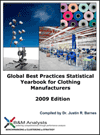|
The Yearbook provides an exhaustive – and impartial – analysis of operational performance and competitiveness issues, underpinned by a proprietary database of 84 clothing manufacturers and Cut, Make and Trim operations located in Asia, the Americas and Southern Africa, as well as three size categories and three location-specific categories.
The Yearbook covers the entire value chain, and enables senior members of an organisation – from Purchasing, Quality Control, Finance and HR executives – right up to the CEO to better understand either their, or their supply chain’s competitiveness standing in relation to international performance standards on a number of key best practice fronts:
- Financial performance
- Inventory control
- Internal and external quality performance
- Internal and external reliability
- Internal and external flexibility
- Human resource performance
- Product innovation
- Cost benchmark performance
Report structure
Section 1 provides a full explanation of each of the market drivers around which the Yearbook is organised, in addition to the formulae, definitions and explanations underpinning each of the core competitiveness indicators that highlight comparative performance.
Section 2 presents the competitiveness data in an aggregated form. The clothing manufacturer dataset is presented in both table and figure formats and is broken down according to percentiles, quartiles, means (averages) and medians, enabling easy identification of performance spread across the set of firms. The averages for each of the disaggregated datasets are also presented in this section. The data is disaggregated in terms of three principle categories – clothing manufacturer sub-sector, the size of benchmarked firms, and their geographic location. The section begins with a statistical summary of the average profile and operational performance levels of firms, the cost benchmark performance analysis, and the qualitative review of the key issues that emerge from the data.
The next three sections of the Yearbook then focus upon each of the disaggregated datasets.
Section 3 considers sub-sector specific performance findings according to 7 clothing manufacturer categorisations:
- Men’s casual;
- Men’s formal;
- Ladies’ casual;
- Ladies’ formal;
- Underwear;
- School/sport/workwear; and
- Children’s wear.
Section 4 focuses on the performance findings according to each participating firm’s size, whilst Section 5 completes the data analysis by disaggregating the findings according to geographic location.
As well as the detailed company-level competitiveness data presented in the Yearbook, financial data capturing sales growth, operating profitability, employment change and capital expenditure is also presented in each of these sections.
The Yearbook also contains an exclusive self-assessment tool. This tool has been specifically designed to guide managers at clothing manufacturers through a systematic interrogation of their own company’s performance relative to the Yearbook’s findings – revealing both the comparative strengths and weaknesses of the company.
In addition, the Yearbook contains the following key features:
A summary operational profile and performance measure section, outlining the average performance levels of the companies analysed, as well as a cost benchmark performance analysis. The cost analysis outlines the financial cost to firms of not attaining World Class Manufacturing performance – as identified through the Yearbook’s measurement approach.
-
A brief analytical review of the most pertinent issues that emerge from the average firm-level data, the purpose of which is to highlight those operational areas that need to be focused on at a subsector, market or company-size level to secure superior performance.
-
An appendix that outlines the clothing industry’s latest development trends at a global level.
-
An appendix that contains the profile spread of all industry data included in the Yearbook.
-
A quick reference appendix that will assist the user to seamlessly navigate the Yearbook’s vast content.
The Yearbook provides answers to such vital questions as:
-
What are the rapidly changing standards of the global clothing industry?
-
Using an objective firm-level benchmarking assessment, just how competitive are clothing manufacturers in reality?
-
What defines global best practice standards in respect of the various facets of clothing manufacturer operations? And are these global best practice standards actually achievable?
-
In which areas do clothing manufacturers need to excel and where should firms be focusing their attention to deliver performance standards consistent with that of leading international competitors in the global clothing industry?
-
What costs do clothing manufacturers typically transfer to their customers as a result of operational deficiencies in their own business, and how can these be contained?
-
Does geographical location, company-size, or sub-sector dynamics really matter in respect of performance for firms that fall into specific profile categories?
-
Are company-level measurement systems sufficiently rigorous? Do firms measure the full suite of competitiveness variables included in the Yearbook? If not, which measures are particularly pertinent to firms and how can they begin measuring them?
|



